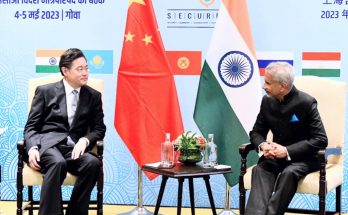 From the Great Wall of China, that remains the Middle Country’s single most stupefying architectural marvel, China could well be moving towards the construction of another ‘Wall,” only this time, one with huge geopolitical significance. As per reports, China is dumping sand to create artificial islands in disputed maritime areas in the South China Sea (SCS), causing grave concerns to the US and its allies like Vietnam and the Philippines, in the region. The claims about this clandestine maritime activity in the South China Sea have also been corroborated by satellite images released by Washington based Centre for Strategic and International Studies. The Philippines too, has come out with photographic evidences to show the development.
From the Great Wall of China, that remains the Middle Country’s single most stupefying architectural marvel, China could well be moving towards the construction of another ‘Wall,” only this time, one with huge geopolitical significance. As per reports, China is dumping sand to create artificial islands in disputed maritime areas in the South China Sea (SCS), causing grave concerns to the US and its allies like Vietnam and the Philippines, in the region. The claims about this clandestine maritime activity in the South China Sea have also been corroborated by satellite images released by Washington based Centre for Strategic and International Studies. The Philippines too, has come out with photographic evidences to show the development.
America’s concern at this development was visible when U.S. Pacific Fleet Commander Admiral Harry Harris Jr. told that China’s unprecedented land reclamation activities – which had now created around 1.5 square miles of artificial land mass with construction still ongoing – raised serious doubts about Beijing’s future intentions. The fact that the US, led by one of its top commanders of the Pacific Command accused China of building a “great wall of sand” in disputed maritime domains in the South China Sea (SCS), has led credence to future concerns arising out of China’s assertiveness.
China’s Great Wall of Sand: the concern
The latest effort from Beijing to construct a sand structure in the SCS lies in the heart of territorially disputed maritime arena. China’s latest construction efforts are near the disputed Mischief Reef. This is on the back of already present/ongoing efforts to build artificial islands in five reefs in the Spratly chain of islands – Gaven, Johnson South, Cuarteron, Hughes and Fiery Cross. Besides, dredging activities are underway in Subi reef. That China is looking for long term benefits out of such strategic locations in the SCS is clear from the nature of Chinese constructions in these island; typhoon shelters, search-and-rescue centres, marine meteorological forecasting stations and civil administration offices. To add to this, in a rare acknowledgement China has declared that the constructions on these artificial islands could be used for military purposes, if needed.
Specifically, regional powers like Vietnam, the Philippines, Taiwan and the most dominant extra regional power, the US, have all opposed the move. There are myriad concerns that the neighbouring counties and more importantly, the US, is dealing with. Apart from the ecological damage that sand-dumping has resulted in (destruction of coral reefs and displacement/destruction of marine habitation), the artificial islands constructed by China have blocked resource-rich areas in the SCS for countries like the Philippines and Vietnam, countries which also lay claims to those areas.
Concerns for the US’ Rebalance
The latest tactic from China has caused a plethora of concerns with the US; first, china’s attempt to create a direct threat to its partners in the region, more particularly Vietnam and the Philippines. Second, it has pushed the US Rebalance strategy on back foot. Third, it has caused grave apprehension that Beijing, likely in future. will only build further on this nature of geopolitics in the SCS. Fourth, the move to dump sand has caused significant coral reef destruction mandating reactions from the concerned quarters and more particularly from the US.
The US’ Rebalance strategy has been under constant flux since its formation, amidst an unsteadily assertive stance from Beijing. First, Beijing forced Washington to a climb-down from its erstwhile ‘pivot-to-Asia’ to ‘Rebalance.’ Second, Chinese declaration of the ADIZ over disputed territories caught the US off guard. More importantly, a series of assertive activities by China vis-à-vis its neighbours and also the US ships present in the region (USS Cowpens) has forced Washington to give its Rebalance strategy an economic bend, particularly by announcing the TPP. China responded quickly by announcing the RCEP. China has been quick in responding to the US’ moves, in effect, making the Rebalance strategy of the US nothing more than an effort-counter-effort game.
The latest move to build a series of artificial islands in the SCS is yet another step by China that has pushed the Rebalance strategy of the US on back foot and is likely to draw a counter-response from Washington. What Beijing’s new geostrategic move has done is that it has thrown another chance for a counter effort to bring a balance to the US’ Asia pacific strategy.
Change of Strategies: Beijing Vs Washington
A common and fair assessment of the trend in Chinese behaviour since the last quarter of 2012, including the latest island building efforts, would have it that Beijing is moving towards a change of strategy apropos its regional presence. A powerful navy has felt the need to expand and be more assertive in the region. This in turn has led Beijing to choose its policies shrewdly, even at the cost of disregarding territorial integrity and flaring up of tensions. One obvious trend in the change in Beijing’s maritime policy has been the attempt to obnubilate the expanse of its nine-dotted-line that in many ways defined traditional Chinese territorial sovereignty. This blurring has accorded a quasi justification to China’s naval expansion and assertiveness.
The voicing of the concern, by none other than one of the top commanders in the Pacific Command (PACOM) and more importantly, one who is lined up to supersede the incumbent PACOM Commander-in-Chief, should be looked at in the light of a prospective change in US’ policy to counter the latest challenge from a renewed policy of land reclamation in the SCS by China. Although a counter-response is awaited from Washington to Beijing’s new strategy, it could get delayed until the soon-to-be change of guard in PACOM.
Author Profile
- India Writes Network (www.indiawrites.org) is an emerging think tank and a media-publishing company focused on international affairs & the India Story. Centre for Global India Insights is the research arm of India Writes Network. To subscribe to India and the World, write to editor@indiawrites.org. A venture of TGII Media Private Limited, a leading media, publishing and consultancy company, IWN has carved a niche for balanced and exhaustive reporting and analysis of international affairs. Eminent personalities, politicians, diplomats, authors, strategy gurus and news-makers have contributed to India Writes Network, as also “India and the World,” a magazine focused on global affairs.
Latest entries
 DiplomacyApril 23, 2024Resetting West Asia, re-booting the world, but not fast enough: T.S. Tirumurti
DiplomacyApril 23, 2024Resetting West Asia, re-booting the world, but not fast enough: T.S. Tirumurti India and the WorldApril 22, 2024India’s G20 Legacy: Mainstreaming Africa, Global South in global agenda
India and the WorldApril 22, 2024India’s G20 Legacy: Mainstreaming Africa, Global South in global agenda DiplomacyApril 10, 2024Diplomat-author Lakshmi Puri pitches for women power at LSR
DiplomacyApril 10, 2024Diplomat-author Lakshmi Puri pitches for women power at LSR India and the WorldApril 6, 2024UN envoy pitches to take India’s solutions to the world stage
India and the WorldApril 6, 2024UN envoy pitches to take India’s solutions to the world stage







